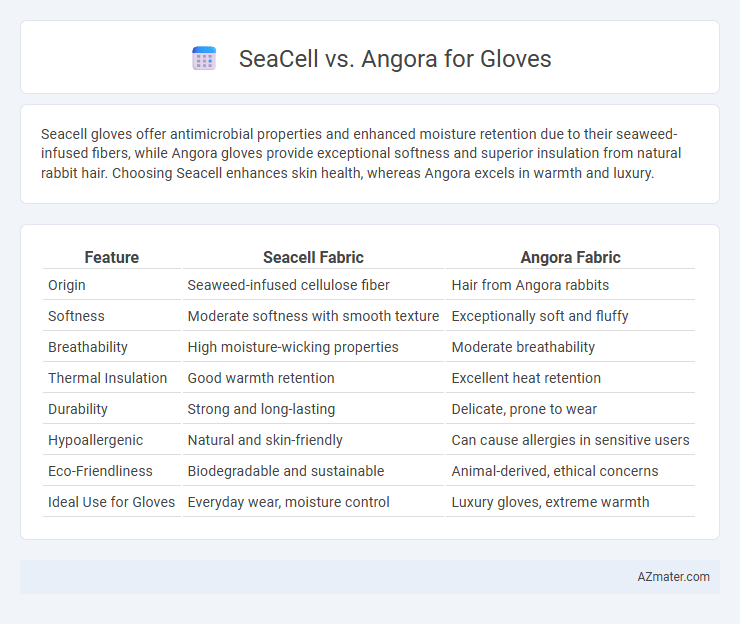Seacell gloves offer antimicrobial properties and enhanced moisture retention due to their seaweed-infused fibers, while Angora gloves provide exceptional softness and superior insulation from natural rabbit hair. Choosing Seacell enhances skin health, whereas Angora excels in warmth and luxury.
Table of Comparison
| Feature | Seacell Fabric | Angora Fabric |
|---|---|---|
| Origin | Seaweed-infused cellulose fiber | Hair from Angora rabbits |
| Softness | Moderate softness with smooth texture | Exceptionally soft and fluffy |
| Breathability | High moisture-wicking properties | Moderate breathability |
| Thermal Insulation | Good warmth retention | Excellent heat retention |
| Durability | Strong and long-lasting | Delicate, prone to wear |
| Hypoallergenic | Natural and skin-friendly | Can cause allergies in sensitive users |
| Eco-Friendliness | Biodegradable and sustainable | Animal-derived, ethical concerns |
| Ideal Use for Gloves | Everyday wear, moisture control | Luxury gloves, extreme warmth |
Introduction to Seacell and Angora Fibers
Seacell fibers are derived from sustainably harvested seaweed combined with cellulose, offering natural moisture retention and skin-friendly properties ideal for gloves. Angora fibers come from Angora rabbits, known for their exceptional softness, warmth, and lightweight feel, enhancing glove comfort during cold conditions. Comparing Seacell and Angora highlights differences in sustainability, thermal insulation, and skin benefits for high-quality glove materials.
Origin and Production Processes
Seacell fibers originate from sustainably harvested brown seaweed blended with cellulose, combining marine benefits with textile innovation. Angora wool is derived from Angora rabbits, requiring a meticulous shearing or combing process to collect fine, lightweight fibers. Seacell production involves an eco-friendly spinning process that preserves seaweed properties, while Angora involves careful animal welfare practices and delicate fiber processing to retain softness and insulating qualities.
Sustainability and Environmental Impact
Seacell fibers, derived from seaweed and cellulose, offer a sustainable alternative to Angora wool by utilizing renewable marine resources with minimal environmental footprint. Angora production involves ethical concerns regarding animal welfare and higher resource consumption, including water and land, which contributes to environmental degradation. Choosing Seacell gloves supports eco-friendly practices through biodegradability and reduced use of harmful chemicals, enhancing sustainability in textile manufacturing.
Texture and Comfort in Glove Use
Seacell gloves offer a silky, smooth texture infused with seaweed fibers that promote moisture retention and skin soothing properties for enhanced comfort during extended wear. Angora gloves provide exceptional softness and warmth due to their fine, lightweight fibers, creating a plush and cozy feel ideal for colder conditions. While Seacell excels in breathability and skin benefits, Angora stands out for its superior insulation and luxurious touch in glove applications.
Thermal Insulation and Warmth
Seacell gloves provide moderate thermal insulation by combining seaweed fibers that enhance moisture management with natural warmth, making them suitable for mild cold conditions. Angora gloves offer superior thermal insulation and exceptional warmth due to the fine angora fibers' excellent heat retention and softness, ideal for extreme cold environments. When comparing thermal efficiency, angora consistently outperforms Seacell in maintaining hand warmth during prolonged exposure to cold temperatures.
Moisture-Wicking and Breathability
Seacell gloves excel in moisture-wicking due to their natural seaweed fibers, effectively drawing sweat away and keeping hands dry during extended wear. Angora gloves offer superior breathability with their fine, lightweight fibers that allow air circulation while maintaining warmth. Combining Seacell's moisture control and Angora's breathability creates an optimal glove choice for active use in varying temperatures.
Hypoallergenic Properties and Skin Sensitivity
Seacell gloves, made from seaweed-infused fibers, offer natural hypoallergenic properties that help reduce skin irritation and promote moisture retention, making them ideal for sensitive skin. Angora gloves, crafted from fine rabbit hair, provide exceptional softness but may trigger allergic reactions in individuals sensitive to animal fibers. For those prioritizing skin sensitivity and hypoallergenic benefits, Seacell gloves present a more suitable option due to their breathable, anti-inflammatory qualities and reduced likelihood of causing allergies.
Durability and Longevity of Seacell vs Angora Gloves
Seacell gloves exhibit superior durability compared to Angora gloves due to their innovative fiber blend incorporating seaweed extracts, which enhances fabric strength and resistance to wear and tear. Angora gloves, while exceptionally soft and warm, tend to have a shorter lifespan because the Angora fibers are delicate and prone to pilling and shedding with frequent use. The longevity of Seacell gloves is significantly higher, making them a more practical choice for those seeking sustained performance and resilience in glove materials.
Care, Maintenance, and Washing Instructions
Seacell gloves require gentle hand washing in cold water with mild detergent to preserve the cellulose fibers infused with seaweed, avoiding bleach and tumble drying to maintain softness and longevity. Angora gloves demand careful handling with cool water and specialized wool detergent, avoiding wringing or twisting to prevent fiber damage and shrinkage, and should be laid flat to dry. Both materials benefit from air drying away from direct heat and sunlight to sustain their delicate texture and insulation properties.
Cost Comparison and Value for Money
Seacell gloves typically cost more upfront than Angora gloves due to their advanced bioactive fiber technology infused with seaweed, offering enhanced skin benefits and odor control. Angora gloves, often priced lower, provide excellent warmth and softness but lack the additional health and skincare advantages found in Seacell. Considering cost comparison and value for money, Seacell gloves deliver greater long-term benefits and durability, justifying their higher price for users seeking both comfort and functional skincare properties.

Infographic: Seacell vs Angora for Glove
 azmater.com
azmater.com